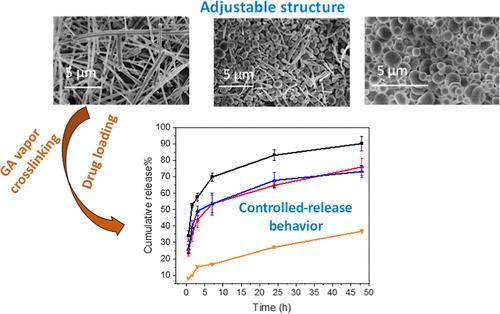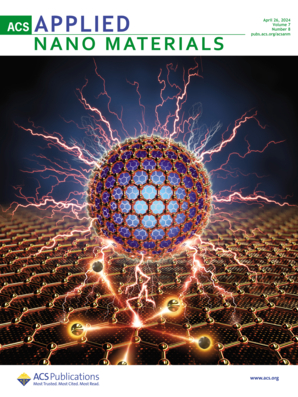用冰模板法制备蛋白质纳米球和纳米纤维以控制疏水性药物的释放
IF 5.3
2区 材料科学
Q2 MATERIALS SCIENCE, MULTIDISCIPLINARY
引用次数: 0
摘要
蛋白质支架在药物输送系统中发挥着重要作用。然而,在生物医学领域,很少有研究关注在蛋白质支架上负载疏水性药物。在此,我们以牛血清白蛋白(BSA)为模型蛋白质,以姜黄素为模型疏水性药物,报道了通过简单的冰模板方法开发蛋白质微球和纳米纤维,并将其用作疏水性药物控释的支架。BSA 支架显示出独特的纳米纤维状和微球状结构。这是一个令人惊奇的发现,因为目前还没有关于通过简单的溶液或悬浮液冰蒸形成微球的报道。为了进一步了解这种方法形成微球的情况,还研究了溶菌酶、木瓜蛋白酶及其与 BSA 的复合材料。据推测,纳米颗粒首先是在 BSA 水溶液中形成的,这归因于水合层的重叠和 BSA 球状分子内部疏水核心的自动组装。然后采用纳米沉淀和浸泡蒸发的方法将姜黄素装入 BSA 支架,再用戊二醛蒸汽交联,以提高其在水介质中的稳定性。实验证明了姜黄素的可控释放,为在这种可生物降解、无免疫原性的蛋白质支架中装载各种疏水性药物以治疗各种疾病铺平了道路。本文章由计算机程序翻译,如有差异,请以英文原文为准。

Protein Nanospheres and Nanofibers Prepared by Ice-Templating for the Controlled Release of Hydrophobic Drugs
Protein scaffolds play a vital role in drug delivery systems. However, few research studies have been focused on loading hydrophobic drugs on protein scaffolds in biomedical fields. Here, we report on the development of protein microspheres and nanofibers by a simple ice-templating approach and their use as scaffolds for the controlled release of hydrophobic drugs, with bovine serum albumin (BSA) as the model protein and curcumin as the model hydrophobic drug. The BSA scaffolds display the unique nanofibrous and microspherical structures. This is a surprising discovery because there has been no report on the formation of microspheres via simple ice-templating of solutions or suspensions. To further understand the formation of microspheres by this approach, lysozyme, papain, and their composites with BSA are also studied. It is speculated that nanoparticles are first formed in aqueous BSA solution, attributed to the overlapping of hydration layers and autoassembly of inner hydrophobic cores of BSA globular molecules. Nanoprecipitation and soaking evaporation approaches are then used to load curcumin into the BSA scaffolds, followed by cross-linking with glutaraldehyde vapor to improve stability in an aqueous medium. The controlled release of curcumin is demonstrated, paving the way for various hydrophobic drugs loaded into this biodegradable and nonimmunogenic protein scaffold for potential treatments of diverse diseases.
求助全文
通过发布文献求助,成功后即可免费获取论文全文。
去求助
来源期刊

ACS Applied Nano Materials
Multiple-
CiteScore
8.30
自引率
3.40%
发文量
1601
期刊介绍:
ACS Applied Nano Materials is an interdisciplinary journal publishing original research covering all aspects of engineering, chemistry, physics and biology relevant to applications of nanomaterials. The journal is devoted to reports of new and original experimental and theoretical research of an applied nature that integrate knowledge in the areas of materials, engineering, physics, bioscience, and chemistry into important applications of nanomaterials.
 求助内容:
求助内容: 应助结果提醒方式:
应助结果提醒方式:


